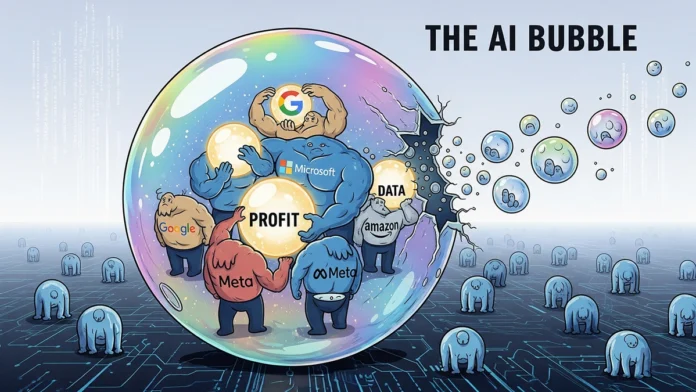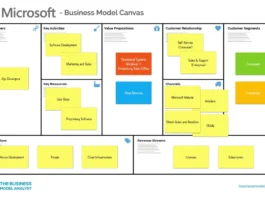Silicon Valley, the land of dreams and disrupted industries, is buzzing – but not entirely with excitement. There’s a growing unease about whether the current frenzy around artificial intelligence is sustainable. We’re seeing huge, complex deals being inked left and right, and some folks are starting to whisper the dreaded words: ” AI bubble .” What’s fueling these concerns? Let’s dive in, shall we? I mean, it’s not everyday that billions are being thrown at companies based on future potential.
The “Why” | What’s Really Driving These AI Deals?

So, what’s behind all this activity? Well, a few things. Firstly, there’s the undeniable hype. Generative AI , machine learning, and all their cousins are being touted as the next big thing – and rightly so, to an extent. But hype can distort reality, leading to inflated valuations and deals that might not make sense in the cold light of day. It’s like the dot-com boom all over again, isn’t it? But the current enthusiasm for AI is arguably different, because this technology actually seems to work! Still, it begs the question whether these deals make sense for investors.
Secondly, there’s the fear of missing out (FOMO), which is a powerful motivator in Silicon Valley. Companies don’t want to be left behind in the AI race, so they’re rushing to acquire AI talent and technology, sometimes paying a premium to do so. Think about it: if your competitors are all investing heavily in AI, you can’t afford to sit on the sidelines, right? One thing I’ve noticed is the willingness of large organizations to experiment with AI. They see the potential rewards, but they also need to be able to handle the potential risks. That being said, how do you handle these risks?
But and here’s the thing — the economics of AI are still uncertain. Many AI companies are burning through cash at an alarming rate, and it’s not clear when or if they’ll become profitable. This is largely due to the high cost of training AI models, the need for specialized talent, and the ever-present risk of technological obsolescence. What fascinates me is how so many of these companies are focused on solving the same problem. This could create a situation where you have multiple companies fighting for the same market share.
Examining the Key Players and Their Strategies
To understand the AI bubble concerns , we need to look at who’s making these deals. You’ve got the usual suspects: the big tech companies (Google, Microsoft, Facebook, Amazon), venture capital firms, and private equity funds. Each has its own strategy. The big tech companies are acquiring AI companies to integrate AI into their existing products and services. Meanwhile, VCs and PE funds are looking for the next big thing, hoping to cash in on the AI boom. But is this approach sustainable for both the companies and the investors?
A common mistake I see people make is not fully understanding the technology. They see the hype, but they don’t grasp the underlying complexities. The one thing you absolutely must double-check, before investing, is the viability of the business model. Is it truly scalable? Does it solve a real problem? These are the kinds of questions investors are asking themselves. It’s easy to get caught up in the hype, but it’s important to take a step back and assess the fundamentals. After all, as we saw with the dot-com bubble, hype can only take you so far.
The Indian Perspective | AI Opportunities and Challenges
What does all this mean for India? Well, India has the potential to be a major player in the AI revolution. With its large pool of talented engineers and growing tech industry, India could become a hub for AI development and deployment. However, India also faces challenges, including a lack of data, a shortage of skilled workers, and inadequate infrastructure. These are challenges that the government and private sector must address if India is to fully capitalize on the opportunities that AI presents. India could become a test bed for new AI applications if these challenges can be overcome.
One crucial aspect for India is ensuring AI ethics and responsible AI development. I initially thought this was straightforward, but then I realized the complexities involved in cultural nuances and data privacy. It’s important to establish guidelines and regulations that ensure AI is used for the benefit of society and does not exacerbate existing inequalities. And this is something that I think should be happening at a global level.
Navigating the Potential Burst | Strategies for Investors
So, how can investors navigate this potentially treacherous landscape? First, do your homework. Don’t just rely on hype or buzzwords. Understand the technology, the business model, and the competitive landscape. I initially thought this was obvious, but then I realized how many people are just throwing money at anything with the words “AI” attached to it.
Second, diversify your investments. Don’t put all your eggs in one AI basket. Spread your risk across different companies, sectors, and geographies. Diversification is key to mitigating risk in any investment portfolio, but it’s especially important in a rapidly evolving field like AI. A common mistake I see people make is investing in just one or two companies. They think they’ve found the next unicorn, but they’re ignoring the fact that most startups fail.
Third, be patient. The AI revolution is likely to take time to unfold. Don’t expect overnight riches. Invest for the long term and be prepared to weather the ups and downs. The one thing you absolutely must double-check is the management team. Are they experienced? Do they have a track record of success? These are the kinds of questions you need to ask yourself.
Final Thoughts | AI’s Long-Term Impact
Let me rephrase that for clarity: Whether or not the current AI frenzy turns into a full-blown bubble, the long-term impact of AI is undeniable. It will transform industries, create new jobs, and change the way we live and work. The key is to approach AI with a balanced perspective, recognizing both its potential and its limitations. The challenges are real, but the opportunities are even greater. And that’s what makes this such an exciting time to be alive. By understanding the landscape, assessing the risks, and focusing on long-term value creation, you can position yourself to benefit from the AI revolution .
The valuations are high, that is true. But the upside is potentially enormous. The smart approach is to focus on companies with solid fundamentals. It’s also a good idea to consult with a financial advisor. They can help you create a personalized investment plan that takes your individual circumstances into account.
It will be interesting to see what happens next. Will the AI bubble burst? Only time will tell. But one thing is certain: AI is here to stay, and it will continue to transform our world in profound ways. You can learn more about OpenAI’s GPU strategy here .
FAQ Section
What exactly is meant by an “AI bubble“?
An ” AI bubble ” refers to a situation where investments in AI companies become inflated, driven by hype and speculation rather than actual business value. This can lead to unsustainable valuations and a potential market correction.
How can I, as a retail investor, participate in the AI revolution without taking on too much risk?
Consider investing in diversified AI-focused ETFs or mutual funds. Alternatively, research established companies that are integrating AI into their existing businesses. Avoid putting all your eggs in one basket and always do your due diligence.
What are the key differences between the current AI boom and the dot-com bubble of the late 1990s?
Unlike many dot-com companies, some AI companies have real-world applications and are generating revenue. However, both periods share similarities in terms of hype and the potential for inflated valuations. Another key difference is the amount of computing power available now compared to then.
What are the potential ethical implications of AI development, and how can they be addressed?
Ethical concerns include bias in algorithms, job displacement, and data privacy. Addressing these issues requires establishing clear ethical guidelines, promoting transparency, and investing in education and retraining programs. You can read more about Intel’s process here .
How can India leverage its strengths to become a leader in the AI space?
India can capitalize on its large pool of talented engineers and growing tech industry by investing in AI research and development, promoting data accessibility, and fostering collaboration between academia, industry, and government. By focusing on innovation, India can become a global leader in AI.



